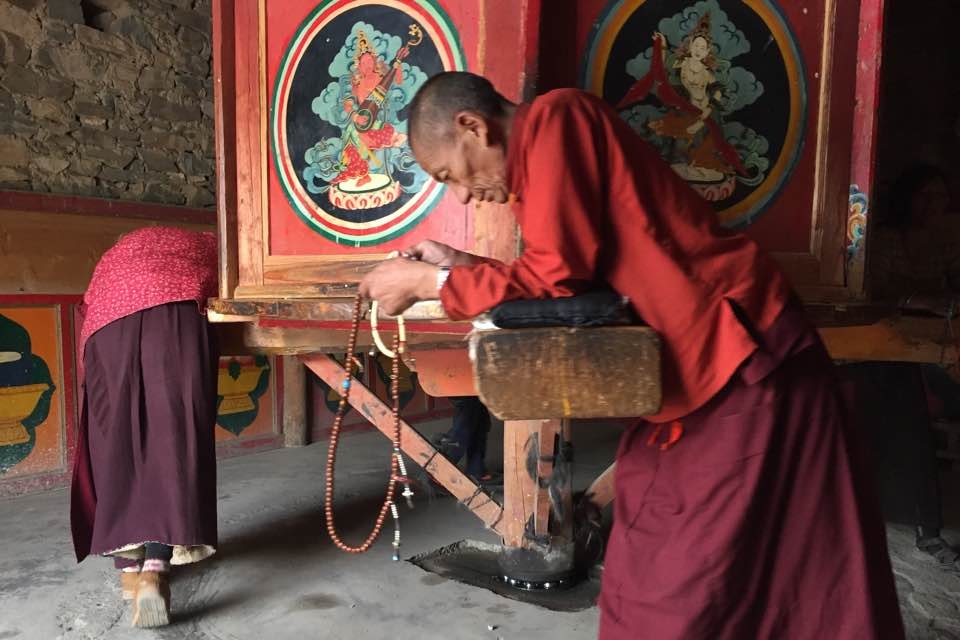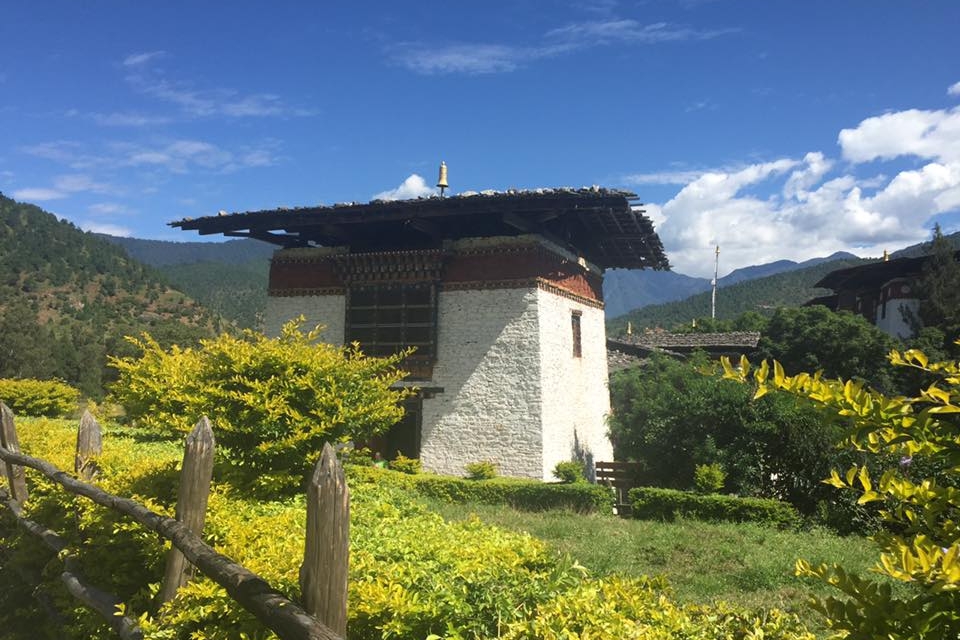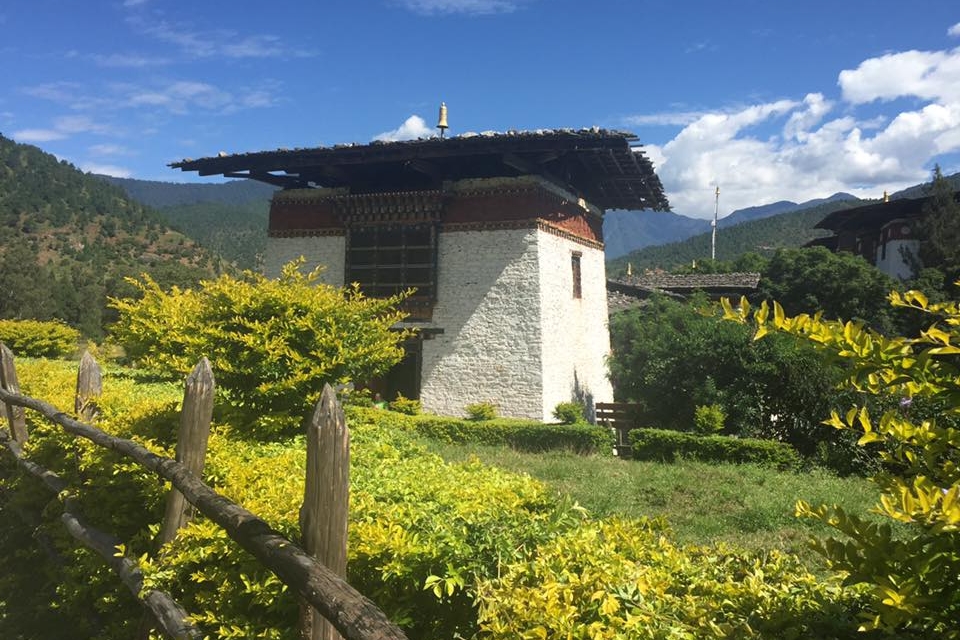Commencing our journey, we fly over passing by Mountains of 5500 meters to Paro. Paro is a beautiful valley and is home to many of Bhutan’s oldest monasteries and temples, and the country’s only international airport. The flight to Paro is one of the most spectacular mountain flights in the world, with a constantly changing panorama of some of the highest mountains on earth including Chomolhari and Jitchu Drake peak. Paro Airport has been described as “the most difficult commercial airport in the world”. 1980 meter runway length presents a double challenge, due to the extremely low density altitude at the site. So, only a handful of well experienced pilots are certified to operate commercial airplanes here thus, making least number of flights in a day.
After immigration and custom formalities, check out from the departure lounge. There you will meet one of the representatives of Nature Trail Travels & Tours, Trekking & Expedition who will greet you and then escort you to Thimphu. Enroute you can visit Ta Dzong Museum housing many religious relics, works of art and handicrafts offering a great orientation into Bhutan’s historical, cultural, and religious past. Next, visit the Rinpung Dzong, meaning ‘fortress of the heap of jewels’ to see the painting of the great saint Milarepa, considered as the master of meditation by the Bhutanese and believed to have attained enlightenment in a lifetime. Dzong’s are large monasteries and district administrative centers, which were once strategic forts. Afterwards, we’ll go to Takin Sanctuary and Zilukha Nunnery. The Takin (a goat-antelope) was declared the national animal of Bhutan because it is strongly associated with the country’s religious history and mythology. Today’s last destination is Thimphu Dzong (Tashichho Dzong), a Buddhist monastery and fortress. It also houses Bhutan’s central government. Then drive to Thimphu following the Pachu River. Once a rustic village sitting in a broad, fertile river valley, Thimphu is today the nation’s bustling capital. Before dinner at the hotel there will be an orientation on Bhutanese etiquette by your guide. Stay overnight at Thimphu.
Drive from your hotel to see the beautiful Punakha dzong (fortress) built between the confluences of two rivers the Pho (male) river and Mo (female) Chu. This dzong is the winter home of the state monastic body and houses the District Administration office. On the way back to your hotel at Wangdi, take a short walk to the Chimmi Lhakhang temple of the Divine Madman Lam Drukpa Kuenley where couples unable to have siblings come here to pray and their prayers are granted.
Afternoon: Walk for 55 Mins to see the Khamsum Yuelley Namgyal Chorten (50 Mins) – temple built by the Queen of Bhutan for peace and stability in this ever-changing world. Overnight hotel.


On the following day, we drive up a winding mountain trail through oak and rhododendron forest. Enroute, we can spend some time in Wangdue Phodrang Dzong perched on a spur at the confluence of two rivers. The position of the Dzong is remarkable as it completely covers the spur and commands an impressive view both up and down the valley. Further, we drive upward over a high pass down into the Phobjikha valley. Here one can enjoy the immense views of the remote Phobjikha Valley and the Black Mountains. Move onto visit Gangtey Gompa (one of Bhutan’s oldest and recently renovated monasteries) and explore the valley where the villagers continue to live a traditional Bhutanese rural lifestyle. This is the site where black-necked cranes visit in their hundreds in November of each year, after spending the summer in Tibet. Explore the colorful, recently-restored Gangtey Gompa, a monastic college famous for its annual festival to welcome the migration of black-necked cranes.


Driving rapidly through a series of hairpins out of Trongsa leaving the views back to the Dzong and out across the valley, we pass through cultivated fields for a while. Then we enter the forest and reach the Yotong La (3400m). Descending to a low point of 2650m at a village called Chumey; the scenery is once again totally different as the route enters the wide-open Bumthang valleys. It takes about an hour to get to the roadside at Chumey, the first of the four valleys in Bumthang. Continue through some of Bhutan’s most idyllic landscapes to Bumthang, an area of high valleys that sits between 2,580 – 3,100 metres. Bumthang is also known as the heartland of Buddhism. The Guru and his lineage of Tertons, treasure finders, have led to the sprouting of many temples in the valley. On arrival at Bumthang, you will stay in a local farmhouse where you’ll experience a genuine slice of Bhutanese life and hospitality. The facilities here are quite basic, but the accommodation is exactly how a typical Bhutanese family live; and the food are in no way adapted for tourists.


Sightseeing tour in the spiritual heartland of Bhutan includes many legendary monasteries, temples and palaces. You will start your pilgrimage sightseeing tour with a visit to Jambay Lhakhang. It was built in the 7th century by the Tibetan King Songtsen Goempo, believed to be the reincarnation of the Buddha of Compassion. It is one of the 108 monasteries built by him to subdue evil spirits in the Himalayan region. The next site we will be visiting today is Chakhar (Iron Castle) Lhakhang. Chakhar Lhakhang lies beyond a short distance from Jambay Temple. Although it is easy to mistake it for a house and drive right by, this is an interesting temple and is worth a short visit. Then drive up to the valley to Kurjey Lhakhang. Kurjey means, “Body imprint”. The temple to the right is the oldest and was built by Minjur Tempa in 1652. It was built around the cave in which Guru Rimpoche meditated and left his body imprint. A few minutes’ walk from Kurjey will lead us to Tamshing Lhakhang. Cross the small suspension bridge and you can see a temple which is known as Tamshing Lhendrup Chholing (Temple of the Good Message).
If time permits, visit the Kungzandra Monastery which is one and half hour walk from the road. It is one of the places where Guru Rinpoche meditated as did his disciple Namkha Nyingpo, and a little temple is said to be to have been established there at the end of the eight century. However the present site was founded by the saint Pema Lingpa in 1488. Overnight Lodge.


After breakfast, drive for about two hours from Choekhor valley to Tang Valley. From Tang valley, a short walk to Membar Tsho “The flaming lake” can be taken. In Membar Tsho, Terton Pema Lingpa discovered a treasure. After the visit, continue the drive towards Mesethang. Short distance away from Mesethang is Tang Rimochen Lhakhang, located below an enormous rock, which is a scared place where Guru Rinpoche mediated. A rock in front of the Lhakhang has a body print of Guru and his two consorts. The name Tag Rimoche (an impression of tiger’s stripes) is derived from the tiger stripes that appear on a rock cliff behind the building. Afterwards, continue the drive to reach Kidzom village. From Kidzom, cross the bridge over Tang chu river and climb up to the hill top Ugyen Choling manor. Ugyen choling palace was originally built by Deb Tsokye Dorji, a descendant of Dorji Lingpa in 16th century. The palace itself has been converted into a museum where they have collected all the antique pieces of things possed by their great ancestors. You can see a lot of old things kept in the museum which provides a better understanding of life in Bhutan during olden days.


After breakfast, drive towards the Ura valley which is 42 kilometers away from Bumthang. The road reaches the Ura Shelthangla from where a magnificent view of Bhutan’s highest peak, Gangkhar Puensum (7,500 m) can be spotted. The road then descends into Ura valley by long loops across fields and pastures. Ura’s main occupation is raising sheeps, yaks and the introduction of potato farming has brought a certain degree of prosperity of people. In Ura, visit Ura Lhakhang and picnic lunch will be served at one of many inviting spots. Afternoon, drive back to Bumthang.


After breakfast at Bumthang, we drive for about six hours to reach Wangdue. Wangdue Phodrang Dzong is perched on a spur at the confluence of two rivers. It represents an important gateway to Eastern Bhutan. High on a promontory overlooking the river, this Dzong, founded in 1639, controlled the routes to Trongsa, Punakha, Dagana, and Thimphu. The position of the Dzong is remarkable as it completely covers the spur and commands an impressive view over both the north-south and east-west roads. Punakha and Wangdue Phodrang are administrative centers of their respective Dzong khang or districts. Compared to Thimphu or Paro, the valley is at much lower elevation at about 1250 meter above sea level. Therefore it enjoys subtropical climate with warm summer and pleasant winter. The valley boasts at least two crops a year and subtropical plants like Cactuses, Mandarin, and Bananas grow here. . The small township of Wangdue with clusters of small shops tightly packed together, surrounding a truck stop is quite interesting to visit. Across the river, on the opposite ridge is the village of Richen gang, known for cluster of houses connected to one another. If time permits, the journey can be broken with a visit to Tamchhu Lhakhang built by Than tong Gyalpo, the so-called Iron Bridge Builder. You can continue down the winding pass to the town of Wang due Phodrang. With its diverse climate and rich natural resources Wangdue is home to many rare and exotic animals like Red Panda, Tiger and Leopard. Villages in Wangdue are also known for their slate and stone. Overnight in Wangdue.


After breakfast at Wangdue, drive to Paro. Upon arrival, get refreshed and proceeds for sightseeing. Visit to Ta Dzong Museum for a colorful introduction to Bhutanese art, history and culture. This Museum houses many religious relics, works of art and handicrafts offering a great orientation into Bhutan’s historical, cultural, and religious past. This Dzong was converted into the National Museum in 1968 which boasts antique thangkas, textiles, weapons and armor, household objects and rich assortment of natural and historic artifacts. Here you can also learn about Bhutan’s history. Then we will visit Rinpung Dzong, meaning ‘fortress of the heap of jewels’ to see the painting of the great saint Milarepa, considered as the master of meditation by the Bhutanese and believed to have attained enlightenment in a lifetime. The Dzong was built in 1645 to defend the valley against Tibetan invaders and is recently used as an
administration center and school for monks.


On this day, we drive for about two hours to reach Haa Valley, a steep north-south valley with a narrow floor. Haa valley lies on the Haa District along the western border of Bhutan. An alternative name for the district is “Hidden-Land Rice Valley”. Enroute we come across Chele La Pass (3810 m). The pass is dotted with colorful Buddhist prayer flags and offers stunning views of Mount Chomolhari and the valley below. We hike further down the pass to the Kila Gompa Nunnery, which is perched precariously along the rock face. Next, walk for a few miles through coniferous forests before driving downhill towards the picturesque Haa Valley. The valley is a narrow plain land sandwiched between two steep mountains. It is an awesome place to spend your time in peace away from the hustle bustle of the cities. This palace also has the ability to turn you speechless when the sun sets in the most amazing part of Haa Valley.



On the eleventh day of your tour in Bhutan, you will have a short hike up to Taktsang monastery. Taktsang is a prominent sacred Buddhist site and temple complex perched on the edge of upper Paro Valley. It is also known as the Tiger’s Nest. This magical monastery clings to a vertical granite cliff 300 meter above the valley. Legend has it that the great Guru Padmasambhava flew to this spot on back of a tigress and meditated in a cave during the 8th century. When the Guru finished his meditation, he instructed that the monastery to be built. The temple was built around the cave and is a hallowed shrine for Bhutanese pilgrims. The spectacular view along the way and the historical sites draw many tourists to this imposing monastery. There are also a number of temples scattered along the route. Later we’ll turn to the Paro Dzong, a large Buddhist monastery and fortress, which is considered the best example of Bhutanese architecture. Now it also houses the district Monastic Body and government administrative offices. On the hill above the Dzong stands an ancient watchtower called Ta Dzong, which is the National Museum of Bhutan. Visit Ta Dzong Museumhousing many religious relics, works of art and handicrafts offering a great orientation into Bhutan’s historical, cultural, and religious past. This Dzong was converted into the National Museum in 1968. The museum boasts antique thangkas, textiles, weapons and armor, household objects and rich assortment of natural and historic artifacts. Here you can also learn about Bhutan’s history. After this hike and a short sightseeing tour, we return back to Paro.


Ending our trip, you will be transferred to the airport for your flight back to home. During the flight you will enjoy breathtaking views of the Himalayan peaks that include sacred Bhutanese mountains such as Jomolhari and Jitchu Drake.





Discover incredible offers for your upcoming adventure by subscribing to our newsletter with the latest travel tips and updates.
